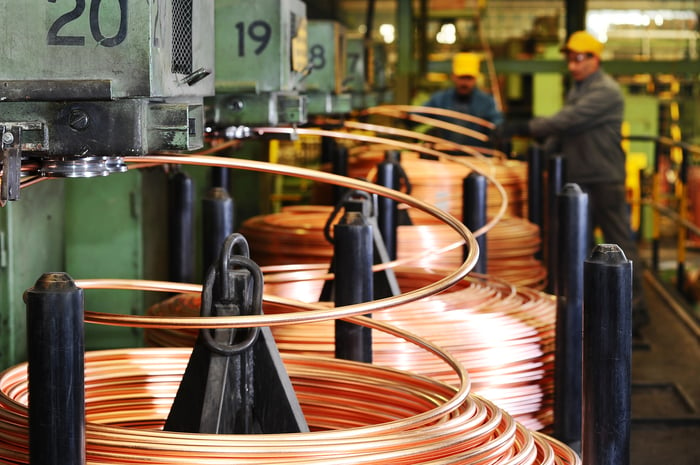Something unusual is happening with copper miner Freeport-McMoRan (FCX -1.35%). Even while the price of copper has risen over the past three months (from around $4.30 per pound to about $4.45 at the time of writing), Freeport’s stock is down by almost 22% over the same period. Although not without reason, the sell-off looks overdone, and the stock looks like a good value. Here’s why.
Why Freeport-McMoRan stock declined
There are probably three reasons for the decline:
- A fire in mid-October at a new Freeport smelter in Indonesia damaged its operations.
- In the fourth quarter earnings call, management lowered its expectations for copper production in 2025 from 4.2 billion pounds to 4 billion pounds, partly due to two major mill repairs in Indonesia.
- Fear over the negative effect of trade tariffs on Freeport’s business.
These issues range from near-term significant to relatively mundane. Starting with the potential tariff effect, Freeport has operations in North America, South America, and Indonesia. When discussing the matter on the recent earnings call, management said that it sells its U.S.-produced copper in the U.S., and if there’s any premium attached to U.S. price as a result of tariff action, then Freeport will be a beneficiary.
According to CEO Kathleen Quirk on the earnings call, Freeport’s copper from Indonesia mainly goes to China, and its South American copper “generally” doesn’t come to the U.S.
Quirk also said she expected the smelter to “recommence production by middle of this year.” As for the downgrade to copper production expectations in 2025, it’s worth noting that there’s no change to the guidance for 4.3 billion pounds of copper production in 2026.
Image source: Getty Images.
Leaching initiatives and cost reduction expectations
While the negative issues appear temporary, there’s reason to believe Freeport is on track for long-term earnings growth. Its most exciting and cost-effective opportunity comes from its leaching initiative technology. Not only does the initiative aim to recover 800 million pounds per annum from 39 billion pounds of material previously considered as waste, it can do so at a relatively low cost. This means that profit margins can expand.
Having hit a run rate of 214 million pounds per annum in 2025, management plans to hit 300 million per annum by the end of 2025 and 400 million pounds per annum by the end of 2026, ultimately reaching 800 million pounds per annum by 2023.
Quirk noted that the leaching cost so far had “been well below $1 incrementally per pound.” For reference, Freeport’s copper unit net cash costs per pound were $1.56 in the fourth quarter.
Moreover, management has cost reduction measures in place in the U.S., from which it hopes to expand profit margins and offset mining lower grades. For example, it’s deploying autonomous trucks in a mine in Arizona and investing in automation and new technology in other mines in anticipation of cutting U.S. unit costs over the next three years.

Image source: Getty Images.
Longer-term risks and opportunities
Freeport has several potential expansion projects in its pipeline from which it could ramp up copper production over the long term. These include a 200-million-pound to 250-million-pound opportunity to expand production in a mine in Bagdad, Arizona (with a decision on it expected by the end of 2025), and a 300-million-pound to 400-million-pound expansion opportunity in a mine in Lone Star, Arizona beginning in the 2030s.
As for risks, the expectation that Freeport will receive an extension to operate beyond 2041 in Indonesia has not changed, but it remains a watch item.
A value stock
Considering all of this, the market seems to have unduly punished Freeport for some near-term issues, which don’t change the company’s long-term outlook. The same long-term risks and opportunities exist that did before the last three months. Moreover, Freeport continues to report good progress on its leaching initiative, and the price of copper is holding up well.

Image source: Getty Images.
If the price of copper stays at around $4.45, management estimates it would generate a little less than $13 billion in earnings before interest, taxes, depreciation, and amortization (EBITDA) in 2026/2027. Based on the current enterprise value, or EV (market cap plus net debt) of $57.7 billion , that would put Freeport on an EV/EBITDA multiple of just 4.4 times EBITDA in the 2026/2027 timeframe based on the current price. That looks like an excellent value.
Lee Samaha has no position in any of the stocks mentioned. The Motley Fool has no position in any of the stocks mentioned. The Motley Fool has a disclosure policy.

